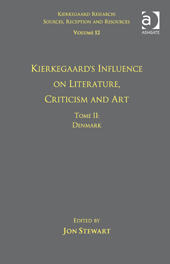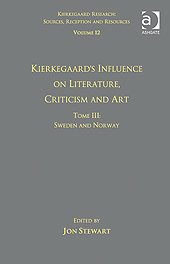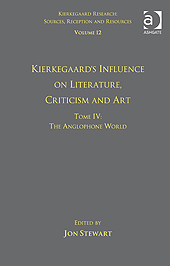
Kierkegaard Research: Sources,
Reception and Resources
|
||

  |
||

|
Volume 12:
Kierkegaard's Influence on Literature, Criticism, and Art
Tome
I:
The Germanophone World Farnham and Burlington: Ashgate 2013. xxi+260pp. Farnham and Burlington: Ashgate 2013. xiii+190pp.
Farnham and Burlington: Ashgate 2013. xiii+202pp.
Farnham and Burlington: Ashgate 2013. xv+239pp.
Tome V: The Romance Languages and
Central Farnham and Burlington: Ashgate 2013. xiii+207pp.
While Kierkegaard is primarily known as a philosopher or religious thinker, his writings have also been used extensively by literary writers, critics and artists. This use can be traced in the work of major cultural figures not just in Denmark and Scandinavia but also in the wider world. These later figures have been attracted to Kierkegaard due to a number of reasons, for example, his creative mixing of genres, his complex use of pseudonyms, his rhetoric and literary style, and his rich images, parables, and allegories. The goal of the present volume is to document this influence in the different language groups and traditions.
Tome I: The Germanophone World
Tome I explores Kierkegaard’s influence on literature and art in the Germanophone world. He was an important source of inspiration for German writers such as Theodor Fontane, Thomas Mann, Rainer Maria Rilke, Alfred Andersch, and Martin Walser. Kierkegaard’s influence was particularly strong in Austria during the generation of modernist authors such as Rudolf Kassner, Karl Kraus, Robert Musil, and Hermann Broch. Due presumably in part to the German translations of Kierkegaard in the Austrian cultural journal Der Brenner, Kierkegaard continued to be used by later figures such as the novelist and playwright, Thomas Bernhard. His thought was also appropriated in Switzerland through the works of Max Frisch and Friedrich Dürrenmatt. The famous Czech author Franz Kafka identified personally with Kierkegaard’s sad love story with Regine Olsen and made use of his reflections on this and other topics.
Table of Contents
Alfred
Andersch: Reading Søren Kierkegaard as
Tome II is dedicated to the use of
Kierkegaard by later Danish writers. Almost from the beginning
Kierkegaard’s works were standard reading for these authors.
Danish novelists and critics from the Modern Breakthrough
movement in the 1870s were among the first to make extensive use
of his writings. These included the theoretical leader of the
movement, the critic Georg Brandes, who wrote an entire book on
Kierkegaard, and the novelists Jens Peter Jacobsen and Henrik
Pontoppidan. The next generation of writers from the turn of the
century and through the First World War also saw in Kierkegaard
important points of inspiration. These included Ernesto Dalgas
and Harald Kidde, who used elements of Kierkegaard’s thought in
their novels. Modern Danish writers such as Karen Blixen, Martin
A. Hansen, and Villy Sørensen have continued to incorporate
Kierkegaard into their works. There can be no doubt that
Kierkegaard has indelibly stamped his name on Danish literature.
Table of Contents
Karen Blixen: Kierkegaard, Isak Dinesen, and the Twisted
Tome III investigates the works of Swedish and Norwegian writers and artists who have been inspired by Kierkegaard. In Sweden the novelist Victoria Benedictsson made use of Kierkegaard during the period of the so-called Modern Breakthrough. Similarly, the celebrated playwright August Strindberg found inspiration in Kierkegaard. Later Swedish writers right up to our own day have continued to draw on his thought. This includes figures such as Selma Lagerlöf, Lars Ahlin, Lars Gyllensten, and Carl-Henning Wijkmark. The Norwegian reception of Kierkegaard also began remarkably early and was shaped by the leading names in Norwegian cultural life. The famous dramatist and poet Henrik Ibsen, despite his coy responses to questions about his relation to Kierkegaard, clearly seems to have been inspired by the Dane in famous works such as Brand. The other great Norwegian national writer and poet Bjørnstjerne Bjørnson, who was influenced by the Modern Breakthrough movement, was also deeply inspired by Kierkegaard. Finally, the celebrated Norwegian artist Edvard Munch (1863-1944) closely studied key Kierkegaardian concepts such as anxiety, and this influence is notable in his iconic paintings such as The Scream.
Table of Contents
Part I: Sweden
Lars Ahlin: Kierkegaard’s Influence—an Ambiguous Matter
Tome IV examines Kierkegaard’s surprisingly extensive influence in the Anglophone world of literature and art. Kierkegaard’s presence has been especially strong in the United States. His thought appears in the work of the novelists Walker Percy, James Baldwin, Flannery O’Conner, William Styron, Don Delillo, and Louise Erdrich. He has also been used by the famous American literary critics, George Steiner and Harold Bloom. The American composer Samuel Barber made use of Kierkegaard in his musical works. Kierkegaard has also exercised an influence on British and Irish letters. The English-born poet W.H. Auden sought in Kierkegaard ideas for his poetic works, and the contemporary English novelist David Lodge has written a novel Therapy, in which Kierkegaard plays an important role. Cryptic traces of Kierkegaard can also be found in the work of the famous Irish writer James Joyce.
Table of Contents
W.H.
Auden: Art and Christianity in an Age of Anxiety
Tome V: The Romance
Languages and Central
Tome V treats the work of a heterogeneous group of writers from the Romance languages and from Central and Eastern Europe who have made use of Kierkegaard in their writings. Kierkegaard has been particularly important for Spanish literature: the Argentine writers Jorge Luis Borges, Leonardo Castellani, and Ernesto Sábato, the Mexican writer Carlos Fuentes, and the Spanish essayist and philosopher María Zambrano were all inspired to varying degrees by him. The Dane also appears in the works of authors writing in other Romance languages, such as the Romanian writer Max Blecher. The Portuguese author Fernando Pessoa was almost certainly inspired by Kierkegaard’s use of pseudonyms. Kierkegaard has also been read by very diverse literary figures from Central and Eastern Europe. He appears in the novels of the contemporary Hungarian authors Péter Nadas and Péter Esterházy. With regard to the Slavic languages, the famous Russian writer, thinker, literary critic, Mikhail Bakhtin, was also inspired by Kierkegaard as was the Polish writer Witold Gombrowicz and the Czech novelist Ivan Klíma. The Polish-born Israeli novelist Pinhas Sadeh was interested in Kierkegaard’s treatment of the story of Abraham and Isaac in Fear and Trembling.
Table of Contents
Part I: Romance Languages
Ivan Klíma: “To Save My Inner World”
|
Kierkegard’s International
Reception
Kierkegaard’s Influence on Existentialism Kierkegaard’s Influence on Theology
Kierkegaard’s Influence on Philosophy
Kierkegaard’s
Influence on Literature and Criticism
Kierkegaard’s
Influence on the Social Sciences Kierkegaard’s Influence on Social-Political Thought
|
|
The
series Kierkegaard Research: Sources,
Reception and Resources is published Routledge Research, Philosophy
Routledge / Taylor & Francis Group, 711 Third Ave., Eighth Floor, New York, NY 10017, USA
Jon Stewart©2007-2020 |
||












